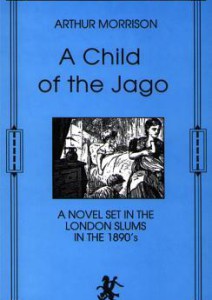Arthur Morrison’s 1890’s novel A Child of the Jago is set in the slum courts of London’s East End. Life in the Jago is a Hobbesian war of all against all, a socialist Darwinist nightmare for which the legal jurisdiction is the law of the jungle. Based on the historic rookeries of London’s Old Nichol, the Jago is not only a geographical area but an existential state of desperation.
Morrison penned A Child of the Jago in such a way as to both inform and also shock and titillate middle-class readers. It brings to life conditions already long familiar through Henry Mayhew’s London Labour and the London Poor, presenting a kind of anthropology of Cockney life. The characters speak with an argot anticipating Anthony’s Burgess’s Clockwork Orange, with which it also shares the street violence of Richard Allen’s 1970’s novels. ‘Whoever’, writes Morrison, ‘was too young, too old or too weak to fight for it must keep what he had well hidden, in the Jago’ (46). The only traces of social solidarity are found within the family unit or in the face of agreed common enemies. The Jago is riven by violent factional animosities with regular pitched battles between the Leary and the Rann families and their allies. However, Jagos will unite to attack detested Dove Laners in the neighbouring courts and all will close ranks to fight the greatest common foe, the police for whom the rookeries are a no-go zone.
Life in the Jago is experienced through the misfortunes of the Perrott family (a Huguenot name), and particularly the child of the Jago himself, Dick Perrott. Old Beveridge advises Dick Perrott that there are three ways out of the Jago; the gaol, the gallows or to become ruthless enough to become one of those ‘grandees of rascality’ (51), the gangsters known as the high mobsmen. His father Josh Perrott is on one brief occasion able to get his bloodied hands on serious money by defeating rival Billy Leary in a prize-fight, a lively set piece at the centre of the novel. Lacking his father’s physical prowess at 5ft 2”, however, even this route to fortune is closed to Dick. His mother Hannah undertakes precarious home employment in such sweated labour as is sometimes available – unskilled piecework stitching sacks, weaving rush mats or assembling matchboxes. In a tale with some elements of the picaresque, Dick’s one lucky break, as a shop boy, is snatched from him by the treachery of coffee shop owner and local fence, Weech. While the rookeries cover a small area they are crowded with a compressed population lost in an endlessly labyrinthine world of Piranesian courts and alleys. Samuel Smiles’ great Victorian promise of social mobility through self-help is a lie. The closing irony therefore is that Dick finds a fourth, equally tragic, exit from Jago.
Critical debate was concerned with whether Morrison’s novel was realistic or sensationalist. Robert Blatchford, the socialist editor of The Clarion, insisted that the reality was even worse than that depicted in A Child of the Jago. In My Favourite Books (1900), Blatchford suggested that Morrison had the spared his readers’ sensitivities by toning down, and hence distorting, an even bleaker reality. Blatchford believed Morrison had downplayed the facts of slum life, claiming that sickness and disease afflicted over 60% of slum residents, that slum children typically became prostitutes before they reached their teens. He also pointed out that the brawling women of Morrison’s novel tear each other’s hair out in silence ‘because no publisher will print’ the adjectives that they would have used (‘On Realism’, 26-7).
The novel is marred by stock portrayals, featuring such stereotypes as Pigeony Poll, the good-natured prostitute, and anti-Semitic descriptions of fences such as Cohen and lacks Charles Dickens’ endlessly creative characterisations and wit. Nevertheless, despite such weaknesses, Morrison’s first-hand knowledge of the area he was describing make his efforts to capture a raw slice of a vanishing East End a fascinating example of Victorian literature of social crime. Towards the novel’s conclusion the steady process of slum clearance is already apparent, with incursions of new housing starting to erode the heartlands of the old Jago against the residents’ spirited but piecemeal resistance.
